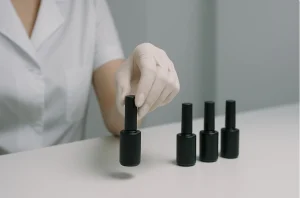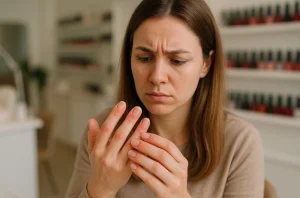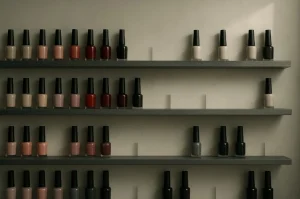Why Are People Asking About Bans on Gel Nail Polish?
Why would something as glamorous and harmless-looking as a gel manicure spark debates about bans and health warnings?
Why do European authorities take a stricter approach to certain ingredients, while the UK and US still allow them? These are the questions that many consumers are now asking, especially after reports of allergic reactions, fertility concerns, and stricter cosmetic regulations.
Gel polish has long been popular for its durability, high-gloss finish, and ability to keep nails looking pristine for weeks rather than days.
But the same technology that makes gel polish effective also brings questions about what it leaves behind in the body, how it interacts with hormones, and whether repeated UV curing is entirely safe.
The growing global conversation about its risks, particularly the banning of specific chemicals such as trimethylbenzoyl diphenylphosphine oxide (TPO), has transformed a beauty trend into a health and regulatory issue.
What Ingredient Was Banned in Europe and Why?

The European Union officially banned TPO (trimethylbenzoyl diphenylphosphine oxide) from all cosmetic products as of September 2024.
This ingredient, widely used in gel nail polishes, serves as a photoinitiator. In simple terms, it triggers the curing process that makes gel polish harden quickly under UV lamps, giving nails their long-lasting, chip-resistant finish. It also plays a role in maintaining vibrant colour and shine.
However, studies linked TPO to fertility issues and potential hormonal disruption. While some experts argued that the scientific evidence was not conclusive enough, the EU took a precautionary approach.
Regulators prioritised public health over commercial benefits, instructing salons across Europe to stop using products containing TPO and to dispose of any existing stock. Manufacturers were also ordered to reformulate their products without the chemical.
The ban not only affected salons but also disrupted the supply chain, as many brands had to halt production temporarily while developing TPO-free alternatives. This shows how seriously the EU views potential threats to human health, even when scientific debates remain unsettled.
Why Hasn’t the UK or US Implemented the Same Ban?
Unlike the EU, the United Kingdom and the United States have not yet banned TPO in gel nail products. In the UK, industry experts predict a similar restriction may come into effect by late 2026, giving regulators more time to assess the evidence and balance the potential risks with the economic consequences.
In the US, cosmetic regulations are generally less strict than in Europe. The Food and Drug Administration (FDA) does not pre-approve cosmetic ingredients in the same way as EU regulators. This means many products containing TPO remain legally available in American salons and retail outlets.
However, the EU’s decision still indirectly affects the US market. Many American salons and distributors import products from Europe. If those products are reformulated to be TPO-free, the US will also experience a shift in supply, even without an official domestic ban.
What Are the Health Concerns Associated with Gel Nail Polish?

The health risks associated with gel polish are not confined to one ingredient. While TPO has been singled out, other chemicals commonly found in gel and standard polishes raise concerns.
Prolonged exposure to substances like HEMA (hydroxyethyl methacrylate) can lead to painful allergic reactions, including blistering, swelling, and nail loss. Similarly, phthalates, often used as plasticisers in cosmetic products, act as endocrine disruptors.
They interfere with hormone balance, potentially contributing to reproductive disorders, breast cancer, obesity, and developmental delays in children exposed in the womb.
Some studies have also highlighted the presence of formaldehyde in nail hardeners and certain gel systems. This chemical is classified as a human carcinogen and has been linked to respiratory irritation and brittle nails.
The concern is not only immediate allergic responses but also the cumulative impact of exposure over time. Unlike a rash that appears immediately, the potential hormonal and fertility effects of these chemicals may not be visible for years, making it harder to connect symptoms to cosmetic use.
How Might Nail Products Influence Fertility and Reproductive Health?
One of the most pressing reasons for recent bans is the potential link between cosmetic chemicals and fertility issues.
Researchers have found that substances like TPO and phthalates can mimic or block natural hormones such as oestrogen and testosterone. This interference can disrupt menstrual cycles, reduce fertility, and even affect foetal development.
Cases of endometriosis, a painful condition where tissue similar to the womb lining grows outside the uterus, have risen dramatically from just over 3 million worldwide in 1990 to around 190 million today.
While endometriosis has multiple causes, some experts believe that long-term exposure to endocrine-disrupting chemicals is partly responsible for this surge.
Professor Katie Burns, a toxicologist at the University of Cincinnati College of Medicine, has emphasised that many of these chemicals remain in the body for years, stored in fatty tissue.
Over time, they may compromise immune function and trigger reproductive disorders. The issue, therefore, is not only about what these products do immediately, but also how they accumulate silently within the body.
Do All Experts Agree That Bans Are Necessary?
The scientific community remains divided. Some experts and industry leaders argue that bans like the EU’s decision on TPO are not based on sufficiently robust evidence.
For example, Doug Schoon, a scientific consultant, has warned that removing TPO may place unnecessary economic burdens on businesses while wasting stock that might not actually pose real harm. He argues that regulatory actions should be proportionate and supported by clear, reproducible data.
Retailers such as ASAP Nails and Beauty Supply in Belgium have also voiced strong opposition, claiming that the ban will disproportionately harm small businesses and limit consumer choice. They point out that there is “no direct human evidence” proving TPO’s toxicity.
This clash of opinions highlights the complexity of cosmetic regulation. On one hand, precautionary bans aim to protect public health before problems escalate.
On the other, too much caution may strain small businesses and undermine trust in regulatory processes if consumers feel safe products are being unnecessarily restricted.
How Do UV Lamps Add Another Layer of Concern?

Beyond the chemicals in gel polish, the curing process itself is a subject of health debate. Gel manicures rely on UV or LED lamps to harden the polish. These lamps emit ultraviolet radiation, which is known to damage skin cells and increase the risk of cancer with repeated exposure.
Although the dose is significantly lower than that of tanning beds, dermatologists caution that cumulative exposure matters. Over years of regular gel manicures, UV exposure may accelerate skin ageing and increase susceptibility to skin cancers on the hands.
Protective strategies are available, such as applying high-SPF sunscreen to the hands before treatment or wearing UV-protective gloves that expose only the nails. These measures reduce but do not entirely eliminate the risks.
What Safer Alternatives Are Available?
For those unwilling to compromise on nail beauty but concerned about health, several alternatives exist. Some brands now offer TPO-free and HEMA-free gels, while others promote systems like Builder in a Bottle (BIAB) that provide durability without some of the high-risk ingredients.
Traditional nail polish, though less durable, avoids UV curing altogether and often contains fewer aggressive chemicals. A growing niche market also exists for “breathable” nail polishes, designed to minimise toxic exposure while offering colours and finishes similar to standard polishes.
The industry is gradually shifting towards formulations marketed as “free from” harmful ingredients, responding both to consumer demand and stricter regulations.
Is It Safer to Have Gel Nails Applied Professionally or at Home?
Safety often depends more on application than on the product itself. In professional salons, trained nail technicians follow proper curing times, use regulated products, and maintain good ventilation, all of which reduce risks.
At-home kits, by contrast, are more likely to be misused. Some unregulated kits available online contain restricted or banned chemicals. Without proper training, users may under-cure or over-cure the polish, increasing risks of allergic reactions or skin damage.
For those who still prefer DIY applications, choosing trusted brands and following safety guidelines carefully is essential. However, most experts agree that professional application remains safer overall.
Will Gel Nail Polish Be Banned Everywhere in the Future?

It is unlikely that gel nail polish itself will be completely banned worldwide. Instead, specific ingredients like TPO will continue to be phased out as evidence emerges about their risks. By 2026, the UK may adopt restrictions similar to the EU, and other regions could follow.
The future of the nail industry lies in innovation and reformulation. Manufacturers are already developing new photoinitiators and safer polymers to replace banned substances. Over time, consumers can expect to see gel systems that deliver the same glossy, long-lasting results without the chemical baggage.
Conclusion
The question “why is gel nail polish banned?” cannot be answered with a simple yes or no. Gel polish as a whole is not prohibited, but ingredients such as TPO have been banned in Europe due to concerns about fertility and hormonal disruption.
Other chemicals commonly found in nail products, such as phthalates and HEMA, raise additional questions about long-term safety.
The UK and US have not yet followed Europe’s lead, though changes are likely in the coming years. For consumers, the best course of action is to stay informed, seek salons that use regulated, TPO-free and HEMA-free products, and consider alternatives when health concerns outweigh convenience.
The beauty industry is resilient and innovative, and the future of manicures will likely be both glossy and safer.
FAQs
What is TPO, and why was it banned in the EU?
TPO, or trimethylbenzoyl diphenylphosphine oxide, was banned in 2024 due to potential links with fertility issues and hormonal disruption.
Will the UK ban TPO in gel nail products?
It has not yet, but experts expect a similar restriction by late 2026.
Why is TPO still allowed in the US?
The FDA regulates cosmetics less strictly than the EU, so TPO remains legal there for now.
How do nail polish chemicals affect fertility?
Certain ingredients act as endocrine disruptors, interfering with hormone balance and potentially leading to infertility, endometriosis, or developmental issues.
Are UV curing lamps dangerous?
They emit UV radiation, which can increase risks of skin ageing and skin cancer with repeated exposure, though risks can be reduced with SPF and protective gloves.
What are safer alternatives to gel nail polish?
Options include TPO-free gels, HEMA-free formulations, BIAB systems, and traditional or breathable nail polishes.
Is it safer to go to a salon than to use at-home kits?
Yes, salons usually follow safety standards and use regulated products, whereas at-home kits may be unregulated and misused.






